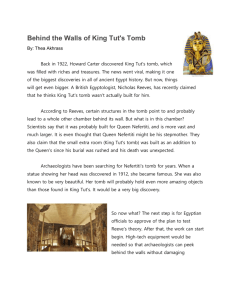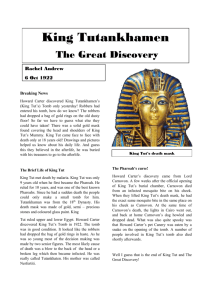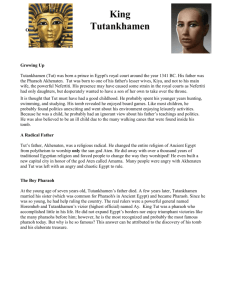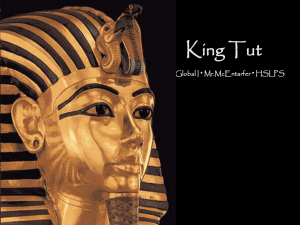King Tut
advertisement
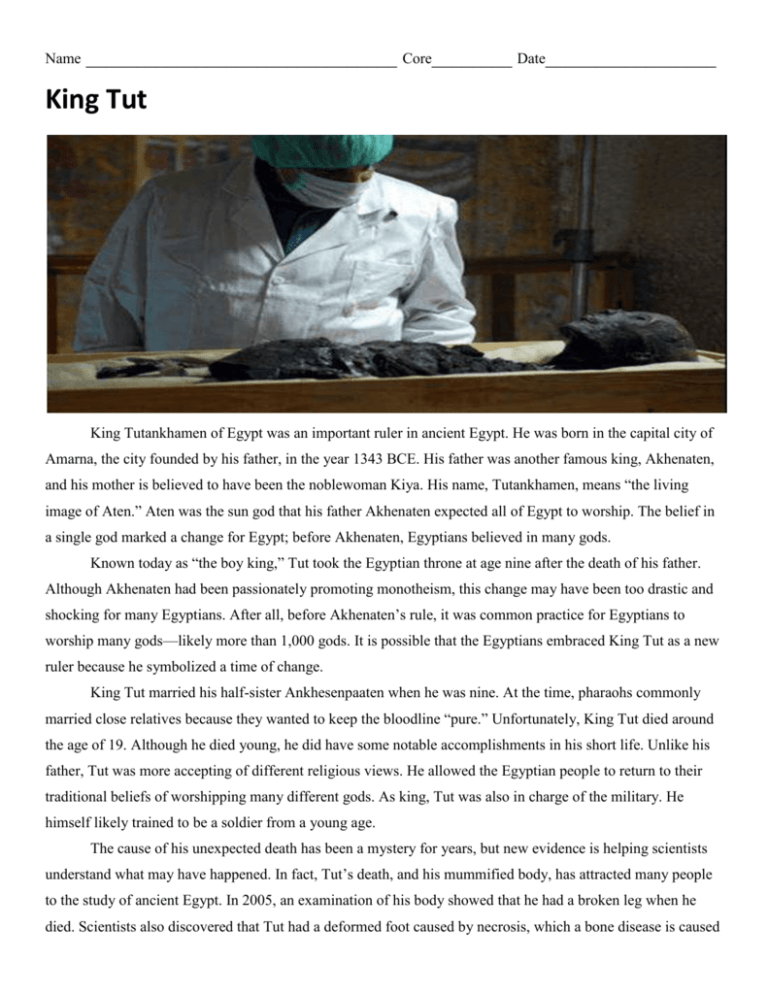
Name _______________________________ Core________ Date_________________ King Tut King Tutankhamen of Egypt was an important ruler in ancient Egypt. He was born in the capital city of Amarna, the city founded by his father, in the year 1343 BCE. His father was another famous king, Akhenaten, and his mother is believed to have been the noblewoman Kiya. His name, Tutankhamen, means “the living image of Aten.” Aten was the sun god that his father Akhenaten expected all of Egypt to worship. The belief in a single god marked a change for Egypt; before Akhenaten, Egyptians believed in many gods. Known today as “the boy king,” Tut took the Egyptian throne at age nine after the death of his father. Although Akhenaten had been passionately promoting monotheism, this change may have been too drastic and shocking for many Egyptians. After all, before Akhenaten’s rule, it was common practice for Egyptians to worship many gods—likely more than 1,000 gods. It is possible that the Egyptians embraced King Tut as a new ruler because he symbolized a time of change. King Tut married his half-sister Ankhesenpaaten when he was nine. At the time, pharaohs commonly married close relatives because they wanted to keep the bloodline “pure.” Unfortunately, King Tut died around the age of 19. Although he died young, he did have some notable accomplishments in his short life. Unlike his father, Tut was more accepting of different religious views. He allowed the Egyptian people to return to their traditional beliefs of worshipping many different gods. As king, Tut was also in charge of the military. He himself likely trained to be a soldier from a young age. The cause of his unexpected death has been a mystery for years, but new evidence is helping scientists understand what may have happened. In fact, Tut’s death, and his mummified body, has attracted many people to the study of ancient Egypt. In 2005, an examination of his body showed that he had a broken leg when he died. Scientists also discovered that Tut had a deformed foot caused by necrosis, which a bone disease is caused by inbreeding. Necrosis causes the tissue within bone to deteriorate. Inbreeding occurs when people breed, or create offspring, with close relatives. There has been significant evidence of complications from malaria, which, combined with Tut’s fracture and genetic bone disease, may have been what killed the young ruler. Yet it is not only the young king who continues to fascinate people. Also remarkable is the tomb he left behind. King Tut was buried in the Valley of the Kings, an area where many pharaohs were buried in elaborate tombs. Many of these tombs had been discovered by looters, who stole the precious artifacts from the tombs. Other tombs were discovered by archaeologists, who excavated and studied them. Tut’s tomb was one of the last tombs discovered. Archaeologist Howard Carter unearthed King Tut’s tomb in 1922 and led a 10-year archaeological dig there. Because of Carter’s magnificent find, many discoveries were made about ancient Egyptian life. Many luxuriant items, including objects made with gold, were found in Tutankhamen’s tomb. The number of items indicates that the pharaoh led a comfortable and luxurious lifestyle. Of the 3,000 items found, Tut’s gold mask is probably the most famous. The gold mask protected the head and shoulders of the mummy. The mask is inlaid with semi-precious stones and is composed of solid gold. In addition to the mask, there was also a solid gold coffin. Egyptians had very detailed methods of preparing pharaohs for burial. Many of the items in the tomb help us learn about Egyptian burial ceremonies. Tut’s tomb includes burial shrines, funeral equipment, and jars holding his internal organs. Model boats were also among the findings. However, these boats were not meant for play. Experts believe that they were included as symbolic vessels to carry King Tut to his afterlife. Other tomb items included chariots, couches, lamps, golden fans, gilded statues, perfumes, oils, linen clothing, and beds. Although King Tut’s tomb seems untouched by bandits, experts believe that thieves did escape with oils from the tomb. These oils were a precious gift in ancient times, produced by a rare plant and treasured for their sweet-smelling fragrances. Multiple beds were among the furniture discovered within the tomb. At least one of them was made of wood gilded with gold. This bed also featured four feline legs to support it. Cats were special, even holy, to the Egyptians, and images of cats were often found on artwork of the time. Highly decorative headrests were used as pillows for these expensive beds. Other beds were made of carved ivory that featured symbols of Egyptian beliefs. Daggers, shields, and other weapons were also found lining the walls of Tut’s tomb. Together with sturdy chariots, these weapons allowed Egyptians soldiers to excel at warfare. The treasures of King Tut show that Egyptians successfully defended their wealth. Judging from the weaponry and illustrations in his tomb, some experts believe that Tutankhamen could have been a warrior king. During his relatively short reign, it is believed that Egypt went to war with a minimum of three neighboring regions. Artifacts also reveal that weaponry was used for hunting game animals. One of Howard Carter’s favorite items was a fan decorated with plumes, or feathers. The inscription showed a hunting scene. In it, King Tut is hunting for ostriches while riding his chariot. In addition to hunting, Egyptians had several things that they enjoyed in their leisure time, including musical instruments, games, and great feasts. Thirty jars of wine were found in King Tut’s tomb! The gaming boards were made of ebony and ivory and included the game of Senet. King Tut must have enjoyed Senet, since a small travel set was found along with the full-size versions. Senet involved two players, each of whose goal was to knock the other player off the board. Senet also included sticks to throw. These sticks functioned like dice do in many modern games. We have learned much about ancient Egyptian life from the artifacts of King Tut’s tomb. Even though his life was short, he remains a well-known figure, in part because of the riches he left behind. It is hard to know how difficult life was during his short life, but his subjects carefully prepared his body for the next life, ensuring it would be an easy journey to the afterlife. No matter what scientists uncover about this boy king, the discovery of his tomb has helped people around the world to learn more about Egypt’s incredible history and culture. __________________________________________________________________________________________ Question (8 points) 1. Preparing for death and the afterlife was an important aspect of Egyptian society. What does King Tut’s tomb tell us about his life and about Egyptian society in general? Use details from the reading passage to support your answer.


